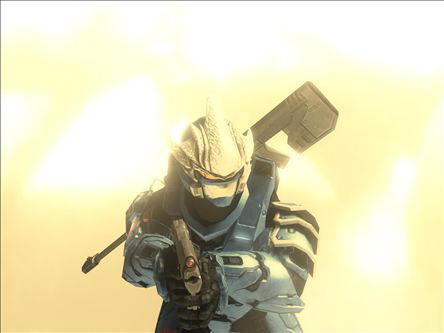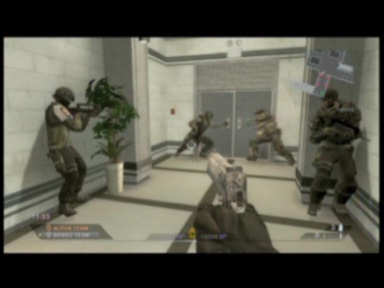|
TRAINING SOLUTIONS
Developing the Tactical
Entry Thought-Process October 2008 |
|
What is Gaming? If you’re idea of video gaming consists of jumping barrels in Donkey Kong or gobbling power pellets in Ms. Pacman, you are way behind the times. Today’s video games immerse the player (or gamer in modern vernacular) within highly complex, 3-dimensional life-like scenarios with near cinematic visuals and sound. And today’s gamers aren’t just playing in static single-player or versus environments; they are hooking up with gamers from across the world in sophisticated online multiplayer platforms. The kinds of people making up the gaming community is changing as well. Today, there are almost as many women gamers as there are men, and most gamers are over 18 years of age. The shear number of people playing video games has exploded in recent years, as well, and there is no sign of its growth slowing down. Perhaps the most important difference between video games of old and the “new-era” of gaming is the linking of gamers via the Internet. Not only are gamers from across the country, indeed the world, able to connect for multiplayer games, modern game consoles include hardware that allow for real-time verbal communication between players. Gaming’s ability to collapse spatial barriers and cultivate communication within a visually and sonically realistic environment lends itself to non-entertainment applications. Training Applications of Gaming Military application of video game technology is nothing new. From the use of flight simulators for training fighter pilots, to the use of the video game program Virtual Iraq to help veterans returning from Iraq cope with post-traumatic stress syndrome, the U.S. Government has sought ways to solve current problems through the latest video game technology. One application being explored by Controlled F.O.R.C.E. Training Systems involves the process of translating skills developed by playing video games into skills necessary for law enforcement and military personnel to perform in modern operating environments. Controlled F.O.R.C.E., a private company that develops Anti-Terrorism / Force Protection training solutions for modern police and military forces, is researching the use of the latest video games, such as Rainbow Six Vegas 2, Halo 3, and Call of Duty 4: Modern Warfare, and their technology to help operators develop the Tactical Entry Thought-Process.
PICTURE: while characters and story lines are often fantasy based, such as in Halo 3, the animations, movements and control responses are becoming increasingly realistic As realistic as gaming is becoming, current models cannot replicate the physical aspects of tactical training. It is impractical to think that gamers that are highly skilled at performing tactical play within game scenarios could effectively perform real tactical maneuvers in a physical environment without having completed rigorous hands-on training. What gaming technology can replicate are the thought-processes and communication skills needed to perform real tactical maneuvers in a physical environment. Develop the Mind and the Body Will Follow Tactical Entry is essentially a set of choreographed movements that operators train through repetition in order to perform in hostile environments. Each team member is responsible for his or her own positioning and movement respective of the team’s movements toward achieving their objective. While scenario-based training has proved to be a useful model for building team tactical skills, Controlled F.O.R.C.E. is exploring the use of video games for developing an operator’s understanding of tactical positioning and maneuvering. Controlled F.O.R.C.E. Chief International Instructor, Tony Grano, has spent nearly twenty years training tactical operators within the law enforcement and armed services communities. “Our goal,” explains Grano, “has always been to seek out new and creative delivery methods in response to growing constrictions on the amount of time operators are able to train, and the amount of money allocated to their training.” The application of video games in Tactical Entry training enables instructors to efficiently build operator comprehension of the choreographed movements before even stepping foot in a training environment. “By utilizing gaming to build understanding,” states Grano, “we can condense weeks of training into days because the operators are already coming in with a fully developed mindset.”
Team Communication Tactical teams are only as strong as their weakest member. This holds true in both online multiplayer gaming and the real tactical operations of SWAT, SRT, Special Forces, etc. Based on the experiences of Grano and his elite team of instructors, communication breakdowns in high-stress situations are common problems faced by tactical teams operating in hostile environments. When developing operators’ skills to work together as a team, the communication component is stressed because communication is essential to teamwork. The way team communication is currently developed, though, could lead to failures in the operating environment. “Communication in the training environment is easy because face-to-face communication is natural to us,” explains Grano. This is where the failure of the training occurs.
When we teach tactical teamwork, we are not going far enough beyond our natural modes of communication to prepare the operator to perform those critical skills in high-stress situations. “The virtual gaming environment removes the familiar face-to-face aspect of communication,” states Grano, “which allows me, as an instructor, to force the operators to go beyond their comfort levels to truly develop their comprehension of team dynamics for them to be able to effectively communicate under stress.” Conclusion: Beyond Training Gaming technology provides creative training solutions, such as developing the Tactical Entry thought-process, but its intended purpose is to entertain. “The great part about using gaming as a training tool,” says Grano, “is that it’s fun.” Through their exploration of gaming technology for training, Controlled F.O.R.C.E. established the C FORCE US Virtual Competition Team to capitalize on the social aspect of gaming. “As we were looking into this, we discovered that there are a lot of great people playing online that enjoyed the same camaraderie and competitive spirit that we did,” states Grano of his and his team’s experience. Indeed, a large portion of gamers that C FORCE US members meet online are law enforcement and military professionals. “The audience is there, infrastructure is there, the technology is there, and the need is there,” notes Grano. “Whether they know it or not, operators are already developing their skills through gaming; now there is real leadership to organize this into a viable training tool.” As the training aspect continues to grow, the C FORCE US competition team is growing as well. “Our backgrounds are law enforcement and military,” states Grano’s partner, Chief International Instructor and C FORCE US player Don Roberts, “so we’re approaching this the same way we approach our training, and that is to win.” Since the majority of gamers are over 18 years of age, and since there is a great competitive spirit inherent to online multiplayer gaming, C FORCE US is looking at taking things one step farther. Explains Grano, “you have social matches, rank matches, pro matches through the MLG [Major League Gaming]. We are looking at the feasibility of gambling matches.” Roberts continues, “our team will out-think you, we will out-maneuver you, and we will out-play you because we understand how to work together as a team.” Grano agrees, “there are a lot of confident players out there that talk a lot of smack. We say, put your money where your mouth is.” RESOURCES: http://www.controlledforce.com/VIRTUAL/c-force-us.htm
|
|
|
|
Copyright 2008 Controlled F.O.R.C.E. Inc |

 PICTURE:
the virtual gaming environment forces players to communicate in order to
work as a team because they cannot rely on visual cues or natural
assumptions of how teammates will act
PICTURE:
the virtual gaming environment forces players to communicate in order to
work as a team because they cannot rely on visual cues or natural
assumptions of how teammates will act